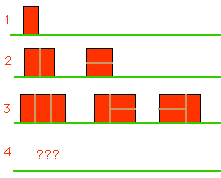
One way to explain that the Fibonacci series is the correct answer is
to show that the problem satisfies the three conditions of the
Fibonacci (Recursive) Definition:
On its own, the formula above is satisifed by many series that are not "the"
Fibonacci numbers because we have not given any starting numbers.
For example, we could start with two 2's as the first pair in the series and then
apply the formula above to get 2+2=4 as the next, (the series is now 2,2,4) and then
2+4=6 as the next one (the series is now 2,2,4,6) as so on to get:
2,2,4,6,10,16,26,42,...
[In fact, this particular series is closely related the "the" Fibonacci series 0,1,1,2,3,5,8,...
- can you spot that relationship?]
So we will need starting values as well as the formula above.
For this puzzle, f(n) means "the number of patterns for walls of height 2 and length n" and the solutions we have at present are

Consider what happens at the left end of the wall....
So the number of patterns of length n is the sum of
the number of patterns of length (n-1)
and the number of patterns of length (n-2). In terms of the "f" notation in
mathematics, we have
With thanks to Mats Lofkvist for helping make this page more accurate.
For this
puzzle we can show that f(1)=1 and that f(2)=2 as follows, using the picture of the
solutions above:
f(1)=1
There is just one pattern for a wall of length 1 (the single brick is placed upright),
so f(1)=1.
f(2)=2
There are 2 patterns if we have a wall of length 2 as we have seen in the diagrams
of the puzzle page,
so f(2)=2
"the number of patterns for walls of height 2 and length 2 is 2".
Now for the general case: f(n)=f(n-1)+f(n-2)
What about f(n) -
the number of patterns for walls of height 2 and length n?
This is the general case and we must be sure that our reasoning applies to
ALL n bigger than 1 (we have covered the two cases for not bigger than 1 above).
There are no more cases and these two cases cover all possible ways of starting a wall
of length bigger than 1. .... either there is a brick on its end
.... either there is a brick on its end
 ....or else there is a brick on its side -
in which case there must be another
one on top of it as there is no other way to make the height of 2.
....or else there is a brick on its side -
in which case there must be another
one on top of it as there is no other way to make the height of 2.
Let's look at these two cases:
So all the ways of finding walls of length n are covered by the two cases:
an upright brick first and then any pattern of length n-1
or else the two-flat-bricks followed by any pattern of length n-2.
So BOTH conditions are fulfilled:
and so the f(n) numbers are indeed the Fibonacci numbers!
© 1996-2006 Dr Ron Knott
![]()
updated: 13 February 2001